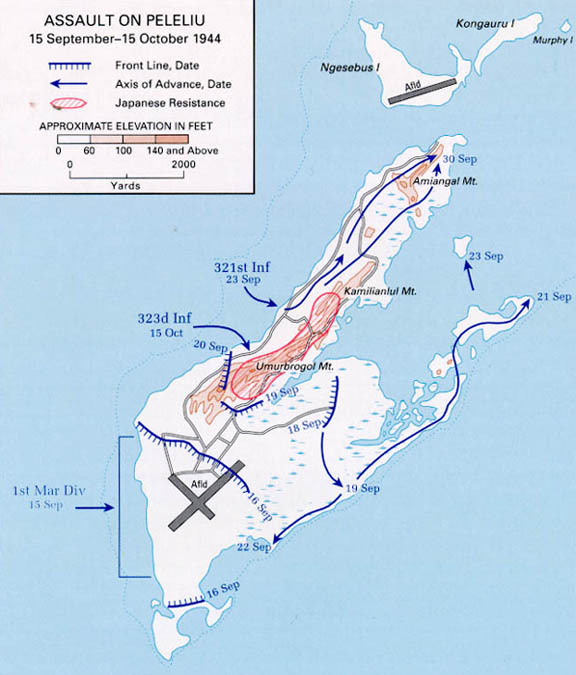
 The invasion of Peleliu began Sep 15 on the west beach and ended, over a month later, at Umurbrogol Mountain.
The invasion of Peleliu began Sep 15 on the west beach and ended, over a month later, at Umurbrogol Mountain.
Peleliu is the southernmost island in the Palau Island chain. It contained a Japanese airbase and sea base. Although the military could have by-passed the island, MacArthur thought that it might jeopardize his invasion of the Philippines. The decision to invade proved to be one of the most controversial of the war.
The Japanese had 10,000 men on the island. The terrain was tailor-made for defense, consisting of limestone hills with over 500 caves connected by tunnels. The Japanese took full advantage of this terrain and had several months to prepare for the anticipated invasion.
Starting on Sep 12, Navy ships and planes began a 3 day bombardment of the island. VC-27 was part of this effort. For this action, the U.S.S. Savo Island was assigned to ComCarDiv-27 (TU-32.7.1) under Rear Admiral William D. Sample. At the end of the 3 days, Rear Admiral Jesse Oldendorf claimed that the Navy had run out of targets. In fact, most of the Japanese positions were unharmed.
On Sep 15, the Marines invaded the island. The capture of the island took over a month and resulted in 11,000 U.S. casualties (2,335 KIA) and 11,000 Japanese casualties (10,695 KIA). Those who were there referred to the battle as "Bloody Peleliu".
In supporting this invasion, VC-27:- Flew 544 sorties and 1,899 hours.
- Damaged or destroyed 96 ground targets.
VC-27 lost 2 Wildcats, flown by Lt(jg) F. M. Leighty and Ens R. H. Dorman.
|
According to AOM l/c Le Blanc's Flight Log Book [Le Blanc was ball turret gunner on Jackson's crew], damage by the squadron included the destruction of Japanese gun emplacements, bivouac areas, barracks, ammunition dumps, barges, warehouses, airstrips, pill boxes, and strafing and bombing of enemy troops. Much of the support called for bombs 150-200 yards ahead of the troops with the squadron establishing a 4.0 record for pin-point drops; there were no bad drops. Heavy antiaircraft fire succeeded in downing one FM-2; fortunately, the pilot was picked up uninjured. * * * So outstanding was the close air-ground support VC-27 gave, that the Commander Support Aircraft and Commander Land Forces praised its effectiveness. A congratulatory message from Adm. Sample, was posted on the Savo Island bulletin board on the 25 September "for the information of all hands": "YOU HAVE COMPLETED 12 DAYS OF CONTINUOUS FULL CUT COMBAT OPERATIONS A TASK UNEQUALED BY ANY OTHER CARRIER GROUP LARGE OR SMALL X YOU HAVE ALSO PERFORMED ALL PHASES OF YOUR VARIED WORK WITH UNIFORM EXCELLENCE THAT COULD NOT HAVE BEEN EXCELLED AND PROBABLY NOT EQUALED EVEN BY THE BIG BOYS X THIS PERFORMANCE IS ALL THE MORE OUTSTANDING BY VIRTUE OF BEING YOUR FIRST COMBAT OPERATION X YOU HAVE ESTABLISHED YOURSELVES AS A FIRST RATE FIGHTING OUTFIT WITH A RECORD ALREADY THAT YOU CAN WELL BE PROUD OF AND I AM GLAD TO BE THE FIRST TO GIVE YOU A WELL DESERVED WELL DONE. ... " The pilots held up well in this protracted period of continuous operations, and lack of fatigue was probably due to the fact that they were fresh, well trained, of high morale, and eager to do well in their first combat operations. There were no VC-27 personnel lost to enemy action during this campaign. |
|---|